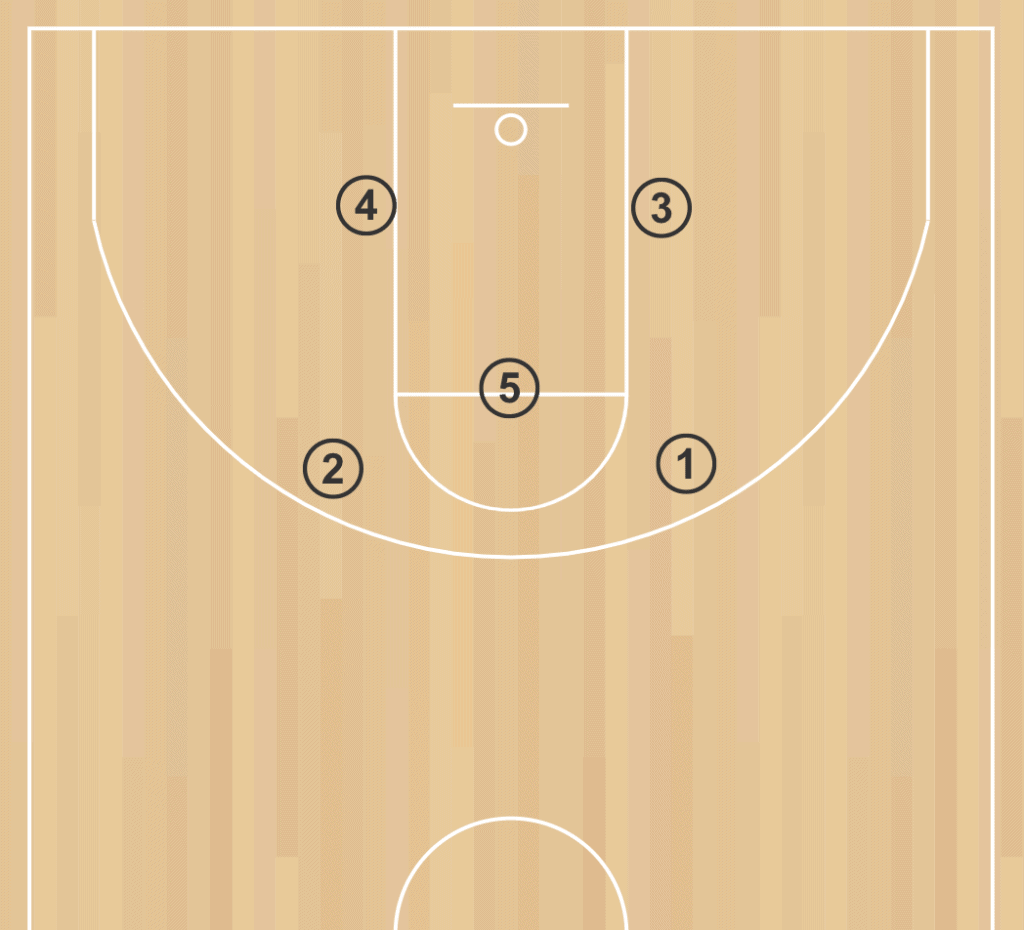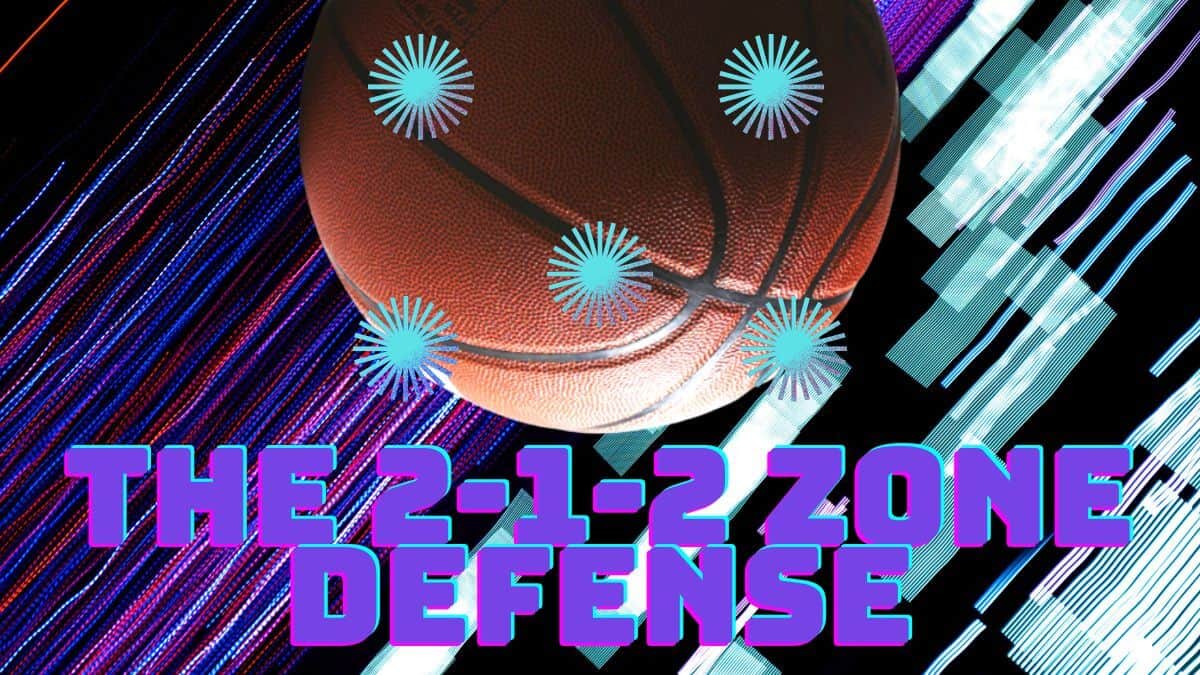What is the 2-1-2 Zone Defense?
The 2-1-2 Defense is a strategy of defense employed in the game of basketball. It is classified as a 1/2 court zone defense. This style of defense is most effective against teams with poor outside shooting efficiency.
It’s easy to get lost in the weeds when it comes to defensive basketball strategy. Unless you understand a multitude of defensive strategies, their strengths and weaknesses, and the core principles driving them, some of these concepts will seem confusing. As you gain knowledge, these ideas gain clarity. Eventually, you will begin to see them pop up in games, and even begin to understand why they’re being employed. It is then that you will begin to feel like a basketball genius.
As usual, we’ll start with a quick breakdown that should catch you up on the basics. We will try to delve progressively deeper into the murky waters of basketball philosophy for those who are still interested. If you need to get up to speed on the basics before we get started, click over here.
What does the 2-1-2 Zone Defense Look Like?
The 2-1-2 Zone Defense Setup
When discussing strategies of zone defense, it’s helpful to discuss the initial setup. This is roughly where we want players to be positioned on the court when approaching a style of defense.
You want 2 defenders up on the 3-point line, off to either side of the key if it were to extend that far. Another player should be positioned at the top of the key. 2 more defenders should be positioned roughly in line with your leading defenders, but back closer to the basket.
Like any system, the initial alignment and rotations are often shifted slightly to fit the situation. But, here’s the rough initial alignment…

Top Defenders
These top players at the 3-point line will often be your guards. They’re responsible for shutting down penetration and guarding the perimeter in their quadrant of the court between the center of the post and the 3-point line.
Bottom Defenders
Bottom defenders are guarding the post, slowing dribble penetration and trolling for rebounds.
Post
The player in the center operates similarly to the bottom defenders, forming the peak of a defensive triangle surrounding the basket. Reach and height and just general shot blocking is most valuable in this position, as it is stretched between the bottom defenders and should be involved in contesting the majority of direct scoring attempts.
This defender will often be your center. This will often be the key to this formation and without the right player here, the strategy can fall apart pretty quickly.
Rotations in the 2-1-2 Zone Defense
The starting position as we covered earlier in this article is ideal if the ball is approaching right down the center of the court. Obviously that’s not always going to be the case. Let’s run through some ideas about how this style of defense should adjust to ball movement.
As the ball moves to either side, the top defender on that side should close out on the ball handler. The top defender on the opposite side should shift a little inward towards the key.
If the ball is moved towards either of the corners, the bottom defender on that side should close out on the ball handler. The post should shift with them to take up some of that space that the bottom defender has opened up. The top defender on that side should set up to guard against passes out of that corner, particularly along the sideline.
If a pass is completed into the center of the formation, the post should be right on top of it, setting up a strong opposition to scoring and pressuring a pass back outside. The 4 surrounding players should shift inwards, further pressuring for a pass back out to the wings and setting up for rebounds.
Theory of the 2-1-2 Zone Defense
This style of defense should shut down movement in the paint. Defenders are consolidated near the basket and any time the ball moves inwards, the entire defense migrates in to squeeze it back out.
Obviously, this invites the opponent to shoot from distance, but that may be just what you’re looking for. It may well be that your opponents shooting percentage from range is low enough, and your team is so packed into the paint as to pick up most of those rebounds, that you gain the statistical edge here.
When to use the 2-1-2 Zone Defense
This style of defense can be popular in youth leagues. It’s easy to teach and organize, but there are plenty of reasons to avoid it. With leagues that rarely attempt outside shots and are inefficient when they do, consolidating your defenders around the paint makes sense.
I’d argue that youth leagues should be geared towards skill development, creating meaningful experiences, and just generally having fun. Any zone defense crowded around the paint is probably going to be effective, but it’s not going to hit any of those notes.
In more advanced leagues, you’re probably not going to see this style of defense unless distance efficiency is very weak or until other strategies have collapsed.
How to Beat the 2-1-2 Zone Defense
There are some features of the 2-1-2 Zone Defense that we can definitely take advantage of.
The most glaring weakness in this style of defense is the lack of perimeter defense. If you’re opponent has any shooting range, you’re just giving away 3-point attempts.
But this defense is also quite dependent on keeping the ball away from the offensive big. If you can’t stifle penetration, keeping the center out of scoring position, you’re going to give up points.
So the mantra for beating the 2-1-2 zone goes something like this…
Either launch and pray, or get the ball to the post.
Th 2-1-2 half court zone collapses quite readily if you can sink 3’s with any reliability. Throw up attempts with your best shooter while your other players drive in for rebound protection. Pay attention to your efficiency. If your efficiency is high enough, just grind away and the numbers will play themselves out.
If you just can’t sink enough 3’s, shovel the ball to the post. Do what you can to create space, moving the ball to get the defense shifted to one side. Drive your post player into the space you’ve created and get them the ball.
The History of the 2-1-2 Zone Defense
The origin of the zone defense itself
It’s tough to trace some of the more specific styles of zone defense back to a solid origin. However, the beginning of zone defense broadly is a fun story.
Around 1910’ish, a High School basketball coach named Cam Henderson was starting out his career in a little town in West Virginia. The town built a brand new court and a gymnasium for the kids to play in, but apparently the wood, having been improperly cured, was vulnerable to leaks. Water frequently pooled around the basketball court during the rainy season.
In order to minimize slipping and injuries, Henderson evolved a strategy that limited his players to certain regions of the floor. This was an early version of the 2-3 zone defense. Henderson went on to coach football, baseball, and basketball at college level into the 20’s, 30’s and 40’s.
Presumably, the various permutations of the zone strategy evolved from this initial concept, and the 2-1-2 zone defense is so similar to the 2-3 zone defense that it probably didn’t take long to hit on this configuration.
How to Teach the 2-1-2 Zone Defense
It depends on the level you’re working at. With younger players, you may not get beyond directing them to a certain region of the court. As the collective IQ of your team trends up, you can incorporate a more complete explanation and work in some drills.
But it is pretty straightforward here to instruct a team where to position themselves on the court and why. Then you can try throwing some offensive attacks at them to see how they respond
Drills to try
It’s generally recommended to focus on your more widely applicable man-to-man defensive skills before zooming in on any strategy, particularly a zone-based schema. There are a ton of great defensive drills out there to experiment with.
But, if you’re looking for some drills that reinforce some of the ideas illustrated here, you should keep it simple. Set your players in their positions. Move in with the ball and guide them through the rotations. As you change your angle of attack, instruct your defenders to adjust their positions to meet you. Increase your pace as your defense gets more comfortable with knowing where they need to be on the floor.
And with any style of play, I always recommend finding ways to naturally stimulate in with your team. Try splitting your team in half and tasking them with either strengthening or breaking this defense. Run a scrimmage, then reverse the tasks and repeat. Analyze the results as a team. What worked? What failed?
What are Some Similar Defensive Strategies to the 2-1-2 Zone Defense?
The 2-1-2 Zone Defense, classified as a zone defense would tend to bare similarities to most half court court zone defense systems. This is very similar to a 2-3 or a 3-2 zone defense and several of the 2-1-2 rotations essentially collapse into a 2-3 system,
